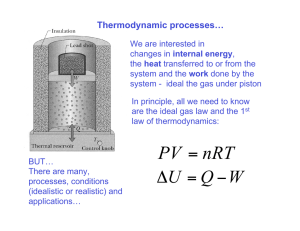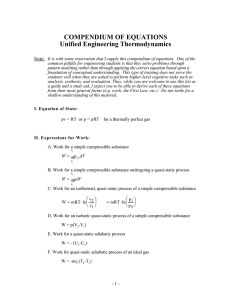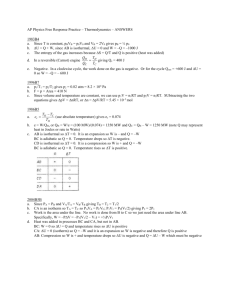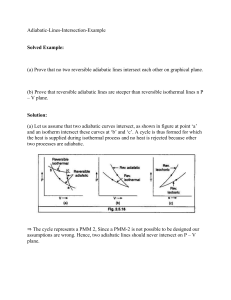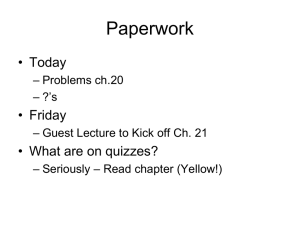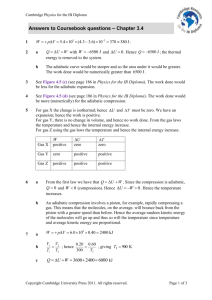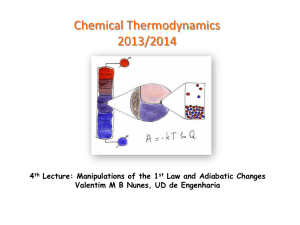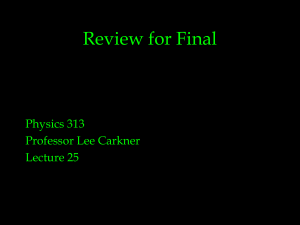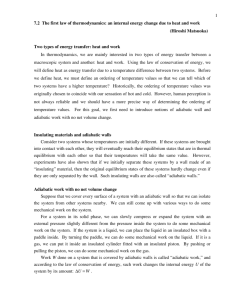Chapter 2 Simple Thermodynamics Systems
advertisement
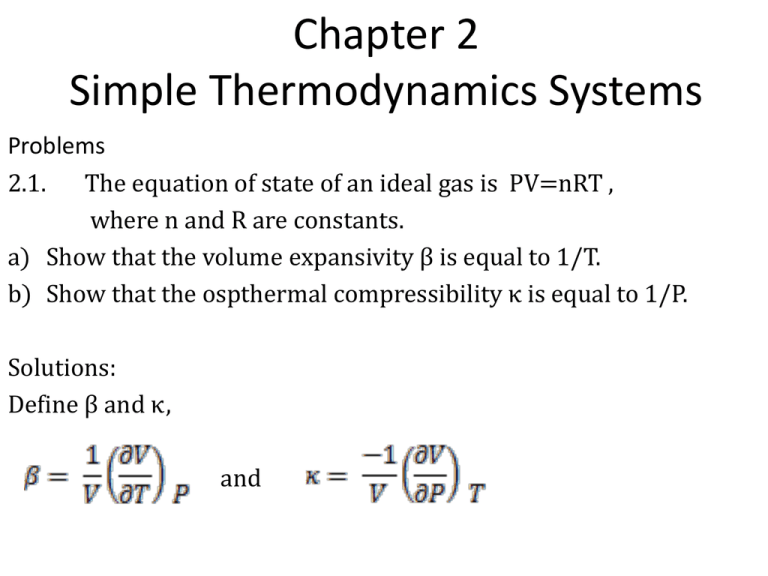
Chapter 2 Simple Thermodynamics Systems Problems 2.1. The equation of state of an ideal gas is PV=nRT , where n and R are constants. a) Show that the volume expansivity β is equal to 1/T. b) Show that the ospthermal compressibility κ is equal to 1/P. Solutions: Define β and κ, and From PV=nRT or V=nRT/P and Therefore, β= κ= 2.2. The equation of state of a van der Waals gas is given as where a, b, and R are constant. Calculate the following quantities : a) (𝜕P/𝜕v)T ; b) (𝜕P/𝜕T)v ; From part (a) anb (b) calculate (𝜕v/𝜕T)P . Solutions: a) b) where any 2 coordinates from x, y and z are independent coordinates. Since any 2 coordinates from P, v and T are independent coordinates, therefore we can write therefore 2.3. a) A block of copper at a pressure of 1 atm (approximately 100kPa) and a tempreture of 5°C is kept at constant volume. If the tempreture is raised to 10°C, what will be the final pressure? b) If the vassel holding the block of copper has a negligible small thermal expansivity and can withstand a maximum pressure of 1000 atm, what is the highest tempreture to which the system may be raised? note: assume that the valume expansivity and isothermal compressibility remain practically constant within the tempreture range of 0 to 20°C at the values of 4.95x10^-5 K^-1 and 6.17x10^-12 Pa^-1. Solutions: a) We choose P as a function of V and T, P= P(V , T). At constant volume, dV=0. Since, Therefore, . =8.03x10^-7 Pa b) =12.4K . 2.4. A block of copper at a pressure of 1 atm, a volume of 100 , and a tempreture of 10°C experiences a rise in tempreture of 5°C and an increase in volume of 0.005 . Assuming the volume expansivity and isothermal compressibility given in Prob. 2.3, calculate the final pressure. Solutions: P = function of ( T , V ), Thus, or = 320atm Chapter 3 Work 3.1 a) Show that the work done by an ideal gas during the quasi-static, isothermal expansion from an initial pressure Pi to a final pressure Pf is given by W=nRTln(Pf/Pi). b) Calculate the work done when the pressure of 1 mol of an ideal gas is decrease quasi-statically from 20 to 1 atm, the temperature remaining constant at 20°C (R=8.31J/mol*K). Solutions: Equation of state for an ideal gas => PV=nRT Work done by an ideal gas, ; ; During isothermal expansion, T is constant b) = -7.29x10^3 J 3.2 An adiabatic chamber with rigid walls consists of two compartments, one containing a gas and the other evacuated; the partition between the two compartments is suddenly removed. Is the work done during an infinitesimal portion of this process (called an adiabatic free expansion ) equal to P dV ? Solutions: No. During a free expansion of a gas, the heat transfer between the system and the surrounding, and the work done by the gas are both equals to zero. In other words, no work is done by the gas during a free expansion. 3.3 a) Calculate the work done upon expansion of 1 mol of gas quasi-statically and isothermally from volume vi to volume vf, when the equation of state is , where a and b are the van der Waals constant. b) If a=1.4x10^9 N*m^4 and b=3.2x10^-5 m^3/mol, how much work is done when the gas expands from a volume of 10 liters to a volume of 22.4 liters at 20°C? Solutions: a) From b) Chapter 4 Heat and First Law of Thermodynamics 4.1 Regarding the internal energy of a hydrostatic system to be a function of T and P, derive the following equations: a) b) c) Solutions: a)U=function of (T,P) (1) First law of Thermodynamics => Substitute (2) into (1), (2) For a hydrostatic system or PVT system, we can write V as a function of T and P. By substituting dV into the second previous equation, we get . b) At constant pressure, dP=0. By dividing dT to the previous equation, we get ; ; Therofore, c) At constant volume, ; Since, Therefore, ; 4.2 Taking U to be a function of P and V, derive the following equations: a) b) c) Solutions: a) U=f(P,V) , and Therefore, b) At constant V, dV=0 and divide by dT, or c) At constant P, dP=0 ; or 4.3 One mole of a gas obeys the van der Waals equation of state: and its molar internal energy is given by where a,b,c and R are constants. Calculate the molar hear capacities cv and cp. Solutions: We write u=function of ( T , v ) and Therefore ∴ Since and ∴ Chapter 5 Ideal Gas 5.1 By defination, the ideal gas satisfies the equations PV=nRT . Find the relationships between Cp and Cv for an ideal gas. Solutions: For an ideal gas, the internal energy function is a function of temperature only. U=f(T) only. For an infinitesimal quasi-static process of a hydrostatic system, the first law is or dQ = dU+ PdV , and the heat capacity at const. volume is given by , and . (i) For a infinitesimal quasi-static process, Pdv + VdP = nRdT. Substituting, we get dQ = ( Cv + nR )dT – VdP and dividing by dT yields At constant pressure, the left-hand member becomes Cp and dP=0, therefore Cp = Cv + nR ( Ideal Gas ) . One more useful equation can be obtained. Since dQ = ( Cv + nR )dT – VdP, we find dQ = CpdT – VdP. (ii) 5.2 An ideal gas undergoes a quasi-static adiabatic process, prove that . Solutions: We start with equations (i) and (ii) from previous question. dQ = CpdT – VdP In an adiabatic process, dQ=0, so V dP = Cp dT, P dV = -Cv dT. Deviding the first equation by the second, we obtain and denoting the ratio of the heat capacities by the symbol γ , we have Most adiabatic process that we encounter do not involve such a large temperature change. Therefore we can regard γ as a constant or neglect the small accompanying change in γ. We obtain ln P = - γ ln V + ln const. or 5.3 Show that for an ideal gas undergoes a quasi-static adiabatic process. Solutions: From therefore and PV=nRT or Since n is the number of mole of a gas, and R is a constant, therefore

